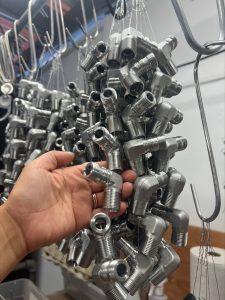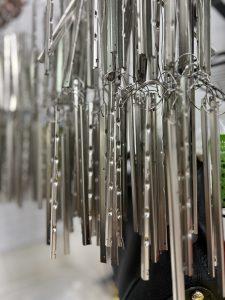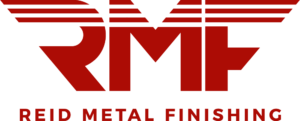Reid Metal Finishing offers passivation for stainless steel components that require superior corrosion resistance. Passivation entails applying a nitric acid solution to stainless steel components after thoroughly cleaning the parts of foreign particulate and oily contaminants. In a nutshell, the passivation procedure results in a thin protective layer of chromium oxide (Cr2O3) that covers the steel surface.
The Goal of Passivation
 Passivation works by enhancing the chemistry and increasing the stability of the passive layer or surface layer, which provides corrosion resistance and protects the material underneath from contamination. This is actually a naturally occurring process in corrosion-resistant and chromium-rich alloys. Given the proper conditions, components made of stainless steels and most other metals should undergo passivation before being used in any operation.
Passivation works by enhancing the chemistry and increasing the stability of the passive layer or surface layer, which provides corrosion resistance and protects the material underneath from contamination. This is actually a naturally occurring process in corrosion-resistant and chromium-rich alloys. Given the proper conditions, components made of stainless steels and most other metals should undergo passivation before being used in any operation.
In essence, passivation is not too different from other plating or anodizing treatments. Clients should consider passivation vs. similar services when evaluating a part’s operating conditions and expected lifetime. Clients should be careful to consider both the average and realistic extreme conditions encountered. This pertains to temperature extremes, pH (acidic/basic) environment exposure and duration, as well as concentrated moisture and salt-attack exposure and duration.
The Benefits of Passivation
 Like other plating and coating technology offered by Reid Metal Finishing, passivation extends a component’s lifetime, especially in humid or salty environments. The client’s investment in passivation will pay for itself with reduced maintenance and part replacement costs. Another benefit of passivation is that it does not inherently change the color or appearance of a stainless steel surface.
Like other plating and coating technology offered by Reid Metal Finishing, passivation extends a component’s lifetime, especially in humid or salty environments. The client’s investment in passivation will pay for itself with reduced maintenance and part replacement costs. Another benefit of passivation is that it does not inherently change the color or appearance of a stainless steel surface.
Passivation is, at its most basic, a cleaning process. It removes surface contamination, while still increasing a component’s corrosion resistance. Whether debris, foreign material, or trace metallic elements, passivation takes care of them all. This process also reduces the risk of product contamination, making it an excellent choice for applications in the Medical and Firearms industry as well.
Choose Reid Metal Finishing for your passivation needs
Regarding passivation or any of our services, Reid Metal Finishing fully understands the related industry standards, such as the ASTM A967, AMS 2700, QQ-P-35, and more. Contact Reid Metal Finishing today to learn more about our company, or to request a quote on your future metal finishing project.
